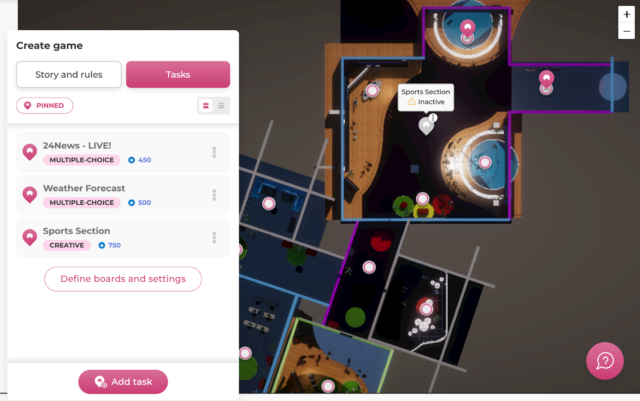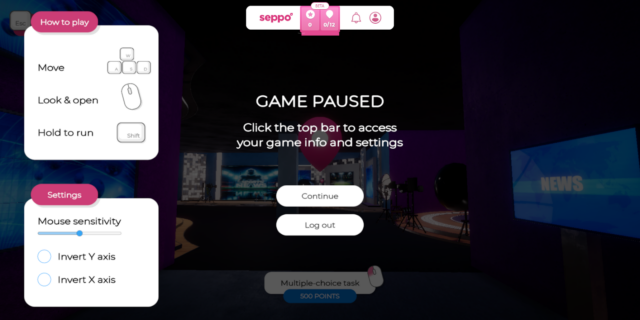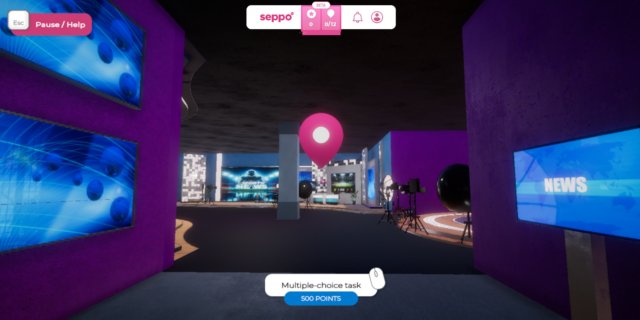Seppo guide
3D Seppo games
Experience Seppo like never before
Seppo games can now be played in exciting 3D environments. These new game boards have been created with the Unity game engine, introducing more gamification elements, bringing the game story to life and making learning games more immersive than ever before.
Creating a 3D Seppo game
Implementing a 3D game board to your own game is easy. Seppo offers multiple game templates through a game package. Access to a 3D game template package can be purchased with an additional license fee. Please contact our customer support if you wish to purchase a 3D game package.
Here’s how you can create a game using a 3D template:
Login to your Seppo account.
Navigate to Game Packages library on your Dashboard.
Download a 3D game template from the package.
The template is now on your dashboard games and you can start editing it.
Creating a game on a 3D game board differs slightly from the standard Seppo game setup. In the editor, you’ll see a 2D overhead view of the 3D environment. White circles on the map indicate designated task placement areas. When a task is added, its pin appears in gray—this means it’s inactive. To activate the task, simply drag the task pin to one of the placement circles.

2D game board in the game editor – task inactive
3D game boards have a varying number of task placement areas, depending on the size of the board. The instructor can choose how many—and which—of these spots to use. Not all placement areas need to be filled.
Some spots, however, have an additional function: they unlock new areas within the board. For example, placing a task on a door can open a new room for players to explore. If a door doesn’t have a task but the room behind it does, the door will automatically be open at the start of the game. If neither the door nor the room have tasks, the door will remain closed.
3D game templates come with built-in themes and gamification elements that enrich the player experience. For example, the Newsroom game board is set in a news broadcast studio, where players complete tasks in a media-rich environment. A standout feature of this game is that players can upload videos as answers, which then appear in the studio—making it feel like their own custom broadcast.
Another example is the Town Adventure, a game board that begins in disrepair. As players complete tasks, the town gradually transforms with animated improvements, offering a visually rewarding experience as the game progresses.
Once your game setup is complete, it’s ready to launch. Players can log in using the game’s pin code via Seppo’s login page. Before entering the game, they’ll see a Unity loading screen.
Playing a 3D Seppo game
When a player logs into a 3D game, the Seppo user interface is displayed over the 3D game board. These games are designed to be played on a computer with a keyboard and mouse. Players can move around the map using the W, A, S, and D or arrow keys, and holding down Shift enables faster movement.
Pressing the Escape key opens the Pause/Help menu, which pauses the game. In this menu, players can adjust mouse sensitivity and invert the horizontal and vertical axes. While playing, the mouse controls the camera angle. Opening the Pause/Help menu also releases the mouse from camera control, allowing access to Seppo’s top bar and settings.
To view elements like the scoreboard during the game, players must first press Escape to pause the game.

The pause menu
Opening a task also releases the mouse, allowing the player to input their answer. To open a task, the player simply needs to walk up to a task pin. When close enough, an overlay appears below the pin, prompting the player to left-click to open the task.

Opening a task pin with left click
With these controls, players can navigate the game board and complete the assigned tasks. Once the game is completed, a special ending screen appears, featuring a cinematic reel of camera angles that showcase the completed game environment. During this sequence, the player can choose to log out or continue exploring the game board by pressing the continue button.